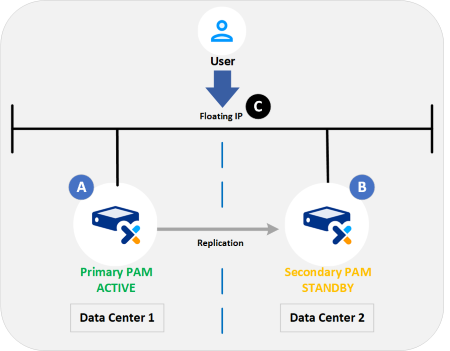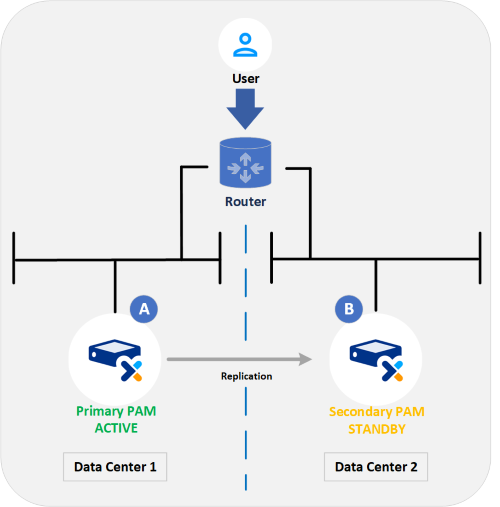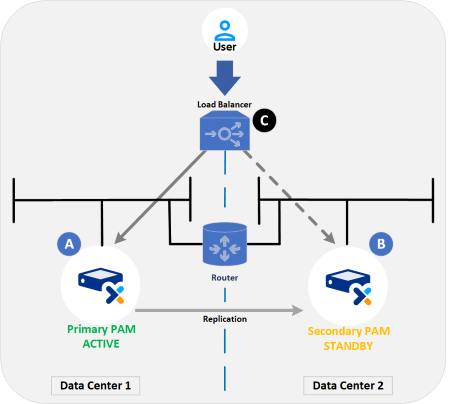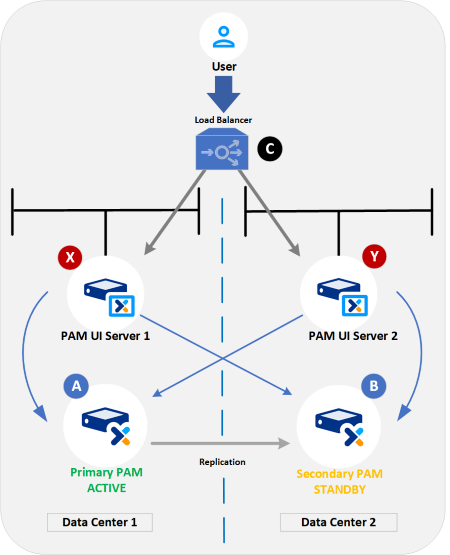PAM High Availability (HA) Installation Scenarios
This section looks at HA Pair installation scenarios:
Introduction
Here we describe and illustrate installation scenarios of how organisations may implement different configurations of a PAM HA Pair. This will help you to plan your implementation based on the needs of your organisation.
Installation scenarios
-
Scenario A: HA Pair in same subnet
In this installation both HA PAM Servers reside on the same subnet with a floating IP used for user connections.
-
Scenario B: HA Pair in different subnets
In this installation both HA PAM Servers reside on different subnets. A floating IP cannot be used.
-
Scenario C: HA Pair in different Subnets and using a load balancer
In this installation both HA PAM Servers reside on different subnets and a load balancer is used to direct user connections to the active server. A floating IP cannot be used.
-
Scenario D: HA Pair using PAM UI Servers in different subnets and using a load balancer
In this installation both HA PAM Servers and PAM UI Servers reside on different subnets.
Scenario A: HA Pair in same subnet
Installation summary:
- Stretched VLAN either in the same or different data centres
- HA Pair (IP address: A, B) and floating IP (C) are all on the same subnet
- Primary server is active
- Secondary server is on standby
- Floating IP used by user to log on
- Manual failure is required by running the
ha-failovercommand on the Management Interface of the Secondary server - IP address does not change during failure as a floating IP is being used

Scenario B: HA Pair in different subnets
Installation summary:
- Separate VLANS either in the same or different data centres
- HA Pair (IP address: A, B) are on separate subnets
- Floating IP cannot be used
- Primary server is active
- Secondary server is on standby
- PAM User logs onto the active server
- Manual failure is required by running the
ha-failovercommand on the Management Interface of the Secondary server - After failover, users need to switch over to the IP of the Secondary server (B)

Scenario C: HA Pair in different subnets and using a load balancer
Installation summary:
- Separate VLANS either in the same or different data centres
- HA Pair (IP address: A, B) are in separate subnets
- Floating IP cannot be used
- Primary server is active
- Secondary server is on standby
- Manual failure is required by running the
ha-failovercommand on the Management Interface of the Secondary server - The load balancer (C) monitors through an API and directs user traffic to the active server. For information on how to configure a load balancer in front of a PAM HA Pair click here
- PAM User uses a virtual IP address configured on the load balancer (C) to log on
- IP address does not change during failure as a virtual IP is used

Scenario D: HA Pair using PAM UI Servers in different subnets and using a load balancer
Installation summary:
- Separate VLANS either in the same or different data centres
- HA Pair (IP address: A, B) and PAM UI Server (IP address: X, Y) either in the same or different data centres
- Primary server is active
- Secondary server is on standby
- Manual failure is required by running the
ha-failovercommand on the Management Interface of the Secondary server - Host file configured on the PAM UI Servers (IP address: X, Y) to include floating IP or HA Pair (A, B) IP addresses to connect to the active server
- PAM User uses a virtual IP address configured on the load balancer (C) to log on
- IP address does not change during failure as a virtual IP is used
